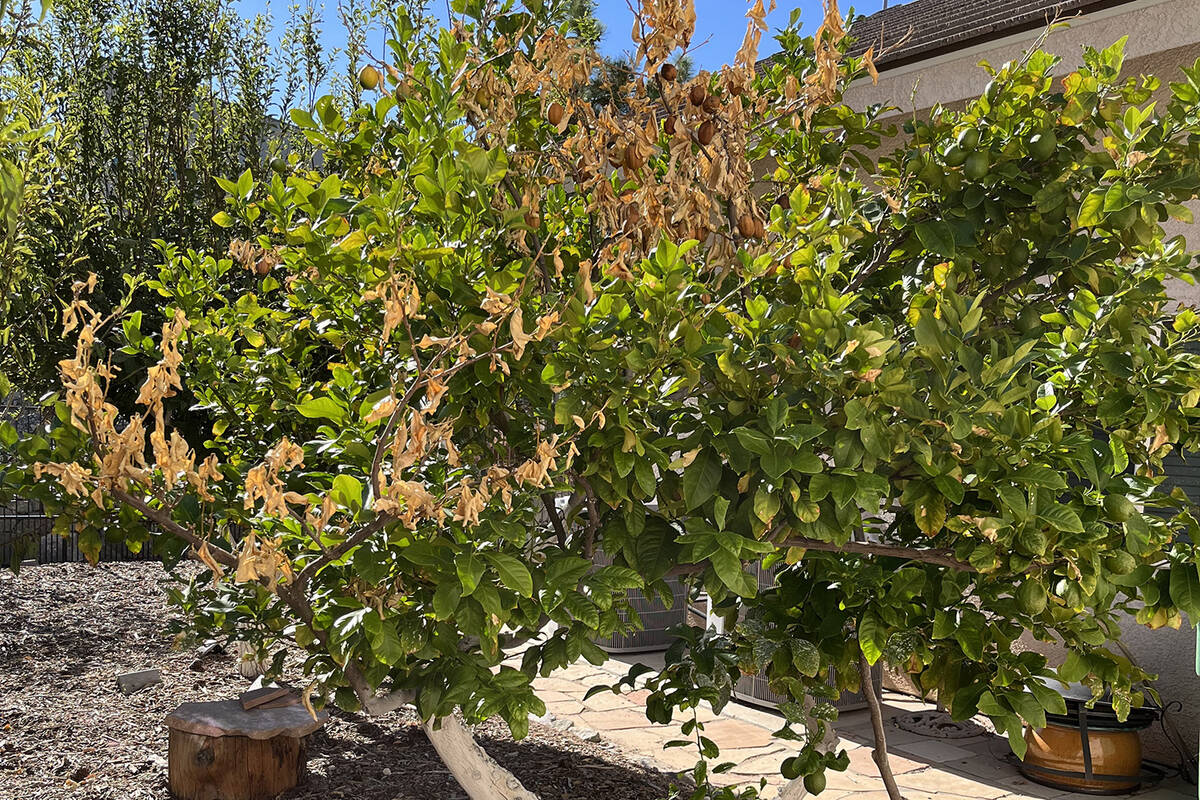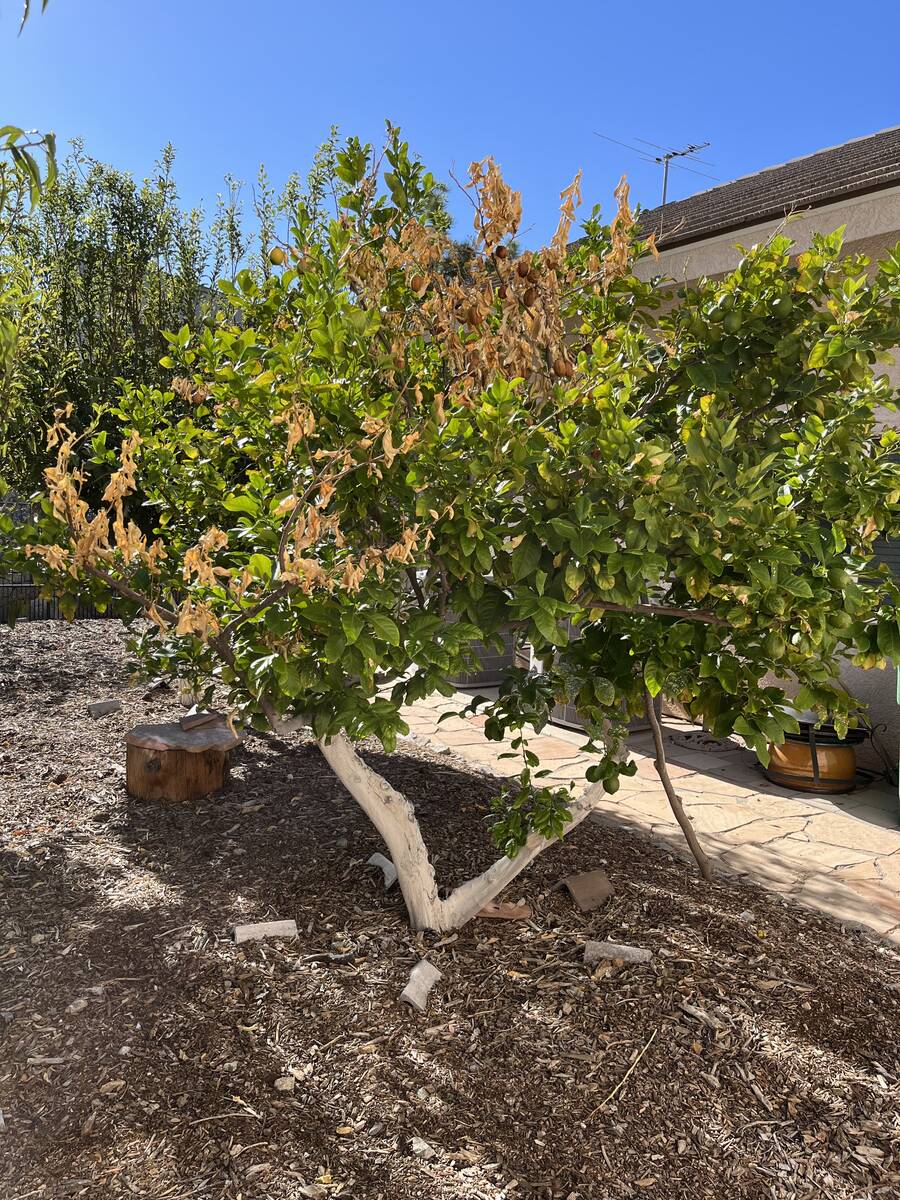Trim dead branches of lemon tree to desired look
Q: I have a Eureka lemon tree with a branch or two that are dying. Is it a borer problem?
A: Branch dieback in citrus, particularly lemon, is very confusing. It is not likely to be a borer problem. Most likely it is a disease issue called “shoot and twig dieback” of citrus. A lot of federal funding went to California to answer branch dieback disease questions from homeowners and commercial growers, with lemon branch dieback found to be quite common.
If it were me, I would cut the dead branches back and eliminate the dead branch to a place where it was healthy and growing in the direction I wanted. As a precaution, I would sanitize the pruning shears with undiluted 70 to 90 percent ethyl alcohol before and after each branch removal. Treat the fresh cuts with copper sulfate (Bordeaux mix) as a precaution.
Q: I had a boxed mastic tree planted recently. I didn’t like how it was planted. It was planted with the trunk not straight, the top of the roots exposed and dry soil in the hole. I had them remove the bottom of the box as they were going to plant it with the bottom of the box still under the root ball.
A: I looked at the pictures you sent to me, and I agree it was not planted well. The hole was dug too small, and it was not planted deep enough. About 30 percent of the soil should be amended for drainage and moisture retention. The soil surrounding your tree may or may not have enough amendments added.
Mastic is related to pistache (Pistache lentiscus). Like all pistache trees, it is mesic in its need for water. This tree is Mediterranean in origin rather than western Chinese or Central Asian.
Water requirements for both are similar and both develop red fall color. It grows well in a lawn where it gets plenty of water if surrounded by other mesic shrubs.
When planting on a slope, the lowest side of the hole should be used for judging the hole depth. This tree is fine growing in soil covered in rock. If this tree shows signs of poor growth in a few years, add a layer of compost on top of the soil and water it in. Water should be applied on the uphill side of the tree but away from the foundation of the house.
The problem with planting in a dry hole is the removal of air pockets. Dry soil pushed around the rootball may or may not remove them. When planting in a slurry of soil, the air pockets are removed at planting time (look for the bubbles), less transplant shock and less concern about tree stability (staking) after planting.
Making a slurry is easy to do. Just use a hose during planting. Sometimes dry soil can be compensated for in the first few months by circling a moist rootball with a moat or donut on top of the rootball when planting and wetting the soil after planting.
This tree grows about 25 feet tall with about the same spread when fully mature. Pay attention to branch direction and the house when planting.
Dig the planting hole at least three times the width of the plant container. The soil removed from the planting hole should be amended with organics of some sort to keep the soil loose, friable and well-drained after planting.
I wouldn’t plant it any closer than 8 to 10 feet from a house to accommodate the watering. Trees should be planted as close to vertical as possible. When trees are planted from a wooden box, usually the bottom of the box is removed first, and the sides are removed after lowering it into the hole.
Q: I planted a very large Bonita ash tree this year and was worried about ash decline disease. This past May, we noticed there were not as many leaves growing as we expected, and many of the ones that were growing scorched and fell off.
After four months of very good care to water, fertilize and condition as told, the Bonita ash tree does not look as we were told when we bought it. While it has grown taller, it had not filled in much.
A: Nearly all ash trees are susceptible to ash decline disease, particularly if it has Arizona ash genetics. Bonita ash does. So do Modesto, Raywood, Rio Grande and other ash trees commonly sold in nurseries.
That being said, this disease is usually not a problem on young ash trees as long as they are not stressed and there are no diseases present that might cause it to spread. Young ash trees are normally very strong and healthy.
The keys to resistance are disease pressure: how much of this disease is present on ash trees in your neighborhood and the health of your trees. The disease agent that causes ash decline is not terribly virulent. It is not like a disease such as fireblight, which can be terribly destructive under the right conditions. If the ash trees in your nearby neighborhood don’t show any symptoms (branch or limb dieback) and are kept healthy, then most likely the tree you planted will live disease free for many years to come.
Make sure your tree is not water- and fertilizer-stressed. All ash trees are mesic in their water needs. Even desert ash trees, such as Arizona ash, grow near waterways.
Like mulberry, all ash trees are dioecious; there are male trees and female trees. There is little difference in the health of a male vs. female ash tree.
Ash trees can get big. Make sure they get enough water as they get bigger. Getting enough water is one key to having a thick and broad canopy and staying healthy. The irrigation under the tree should be enlarged every two to five years to compensate for their increase in size.
The other important ingredient regarding canopy density and health is annual fertilizer applications. At least once a year, apply a fertilizer high in nitrogen — the first number on the fertilizer bag. Examples might include 16-6-8 or 16-16-16.
Ash trees don’t care much for rock on top of the soil unless their roots are growing in rich soil underneath it. Periodically rake any rock away from the trunk of the tree, enlarge the irrigation system and apply compost to the soil surface and fertilizer. The rock can be raked back the same day you are finished.
Q: I have a small tree planted in 1998 that has roots growing under some artificial grass. It was put down many years ago. I have a tree that is sending big roots underneath this grass for probably 10 feet or so. This mound is probably 6 inches or more in height.
I need to know if I pull this artificial grass back and cut that root if that would kill the tree.
A: Maybe and maybe not. It would be difficult to say without looking and making some guesses. Tree roots provide anchorage as well as take up water. If the soil is dry under the artificial grass, then no roots are sent out by the tree.
Trees do not send roots out into dry soil, and they do not get larger unless they have access to water. So possibly that root is still alive. Find out for sure.
Trees send roots out in one or more directions in the presence of water. Tree roots don’t respect property lines and walls. In sandy soil, moist soil can be found about zero to 18 inches from a source of water. In heavier loamy soil, moist soil will be further away, 18 to 36 inches from its water source. If roots find a preferred mix of water and air, they proliferate. If the soil stays dry, then they don’t.
What to do? Look at the area and find the possible sources of water where tree roots might grow. Those spots might have tree roots.
Cut the offending root back in increments until the offending root is not a problem. Stake the tree for one to two seasons of growth and apply water to the areas not root pruned. Prune the tree and remove one-quarter to one-third of its canopy.
Check for the re-establishment of the roots after the second year of growth. Generally, about half of all existing roots can be removed without damaging the tree.
Q: What is wrong with this bush or tree? What can I do to make it look healthy?
A: What I am seeing is a thin canopy and some leaves that have brown tips (leaf scorch). I think this is a ligustrum or privet. When I see a thin canopy, it usually means the soil has run out of organics.
Rake the rock on top of the soil back about 2 feet in all directions and apply a thin layer of compost. This compost will dissolve into the soil with water and increase the organics.
This time of year (beginning of October) we are transitioning from watering three times a week to two times a week. Each application should be about 5 to 10 gallons of water applied to this area via three to four emitters.
This can be calculated with the number of minutes you are applying water combined with the size and number of drip emitters. To change the amount of water, do not alter the minutes but instead change the drip emitters.
The other option is to replace the surface rock with a layer of fine woodchips over this same area.
Bob Morris is a horticulture expert and professor emeritus of the University of Nevada, Las Vegas. Visit his blog at xtremehorticulture.blogspot.com. Send questions to Extremehort@aol.com.























